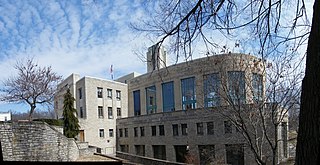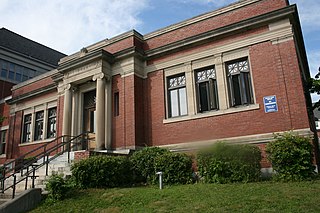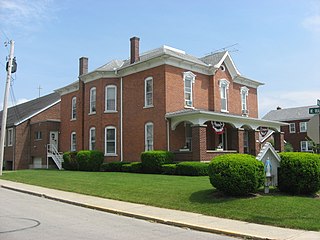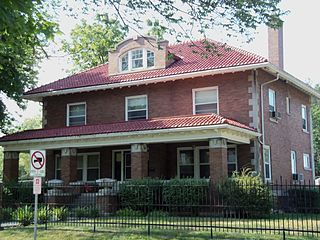
Clay County is located in the U.S. state of Missouri and is part of the Kansas City metropolitan area. As of the 2020 census, the county had a population of 253,335, making it the fifth-most populous county in Missouri. Its county seat is Liberty. The county was organized January 2, 1822, and named in honor of U.S. Representative Henry Clay from Kentucky, later a member of the United States Senate and United States Secretary of State.

Ray County is a county located in the northwestern portion of the U.S. state of Missouri and is part of the Kansas City metropolitan area. As of the 2020 census, the population was 23,158. Its county seat is Richmond. The county was organized November 16, 1820 and named for John Ray, a Missouri state legislator and member of the first state Constitutional Convention.

Excelsior Springs is a city in Clay and Ray counties in the U.S. state of Missouri and part of the Kansas City metropolitan area. The population was 10,553 at the 2020 census. It is located approximately 30 miles (48 km) northeast of central Kansas City, Missouri.

America's 11 Most Endangered Places or America's 11 Most Endangered Historic Places is a list of places in the United States that the National Trust for Historic Preservation considers the most endangered. It aims to inspire Americans to preserve examples of architectural and cultural heritage that could be "relegated to the dustbins of history" without intervention.

The Clay Office and Conference Center is a renovated office complex formerly known as the Clay School. It is located at 453 Martin Luther King, Jr. Boulevard in Midtown Detroit, Michigan. It is the oldest school building in the city of Detroit. It was listed on the National Register of Historic Places and designated a Michigan State Historic Site in 1982.

The Quinsigamond Branch Library, now part of the Quinsigamond Elementary School. is an historic school building and former library at 14 Blackstone River Road in Worcester, Massachusetts. The building was originally built as a Carnegie Library in 1913 with funds donated by Andrew Carnegie, who was present to lay the cornerstone that year. It as since been converted into part of the Quingisamond Elementary School. The building was added to the National Register of Historic Places in 1980.

There are nine historic districts in Meridian, Mississippi. Each of these districts is listed on the National Register of Historic Places. One district, Meridian Downtown Historic District, is a combination of two older districts, Meridian Urban Center Historic District and Union Station Historic District. Many architectural styles are present in the districts, most from the late 19th century and early 20th century, including Queen Anne, Colonial Revival, Italianate, Art Deco, Late Victorian, and Bungalow.

The former Saratoga Gas, Electric Light and Power Company Complex is located near the northern boundary of Saratoga Springs, New York, United States. It is a seven-acre parcel with two brick buildings on it. In the 1880s it became the thriving resort city's first power station.

William Butts Ittner was an architect in St. Louis, Missouri. He designed over 430 school buildings in Missouri and other areas, was president of the St. Louis Chapter of the American Institute of Architects from 1893 to 1895, was awarded an honorary degree by the University of Missouri in 1930, served as president of the Architectural League of America during 1903–04, and at the time of his death was president of the St. Louis Plaza Commission, a fellow and life member of the American Institute of Architects, and a thirty-third degree Mason. He was described as the most influential man in school architecture in the United States and has a star on the St. Louis Walk of Fame. He was appointed St. Louis School Board commissioner in 1897 and is said to have designed open buildings that featured "natural lighting, inviting exteriors, and classrooms tailored to specific needs." In 1936, Ittner died. His legacy is survived by the William B. Ittner, Inc. and Ittner & Bowersox, Inc. architecture firms in St. Louis.

This is a list of the National Register of Historic Places listings in Clay County, Missouri.

Immaculate Conception Catholic Church is a Roman Catholic parish in Botkins, Ohio, United States. Erected in 1865, the parish owns a complex of buildings constructed in a wide range of years, including two that have been designated as historic sites.

Buchanan School, also known as The Naval Station, is a historic building located in the West End of Davenport, Iowa, United States. It was listed on the National Register of Historic Places in 1983. Since 2019 the building has housed a senior living apartment building.

The Arthur Ebeling House is a historic building located on the west side of Davenport, Iowa, United States. The Colonial Revival house was designed by its original owner, Arthur Ebeling. It was built from 1912 to 1913 and it was listed on the National Register of Historic Places in 1984.

The Norwayne Historic District, or Norwayne Subdivision, is an historic residential subdivision, originally built for World War II defense workers. It is located in Westland, Michigan and roughly bounded by Palmer Road on the north, Wildwood Road on the west, Merriman Road on the east, and Glenwood Road and the Wayne County Lower Rouge Parkway on the south. It was listed on the National Register of Historic Places in 2013.

Jefferson School was an elementary school building located at Cape Girardeau, Missouri. It was built in 1904, and is a two-story, red brick and stone elementary school building with a raised sandstone foundation and hipped roof. It featured a bell tower rising above the roofline. It operated as the city's elementary school for African-American students from 1953–1955, when it closed. It was demolished on December 28, 2012.

Ligon Apartments, also known as Udell Apartments, is a historic apartment building located at Excelsior Springs, Clay County, Missouri. It was built in 1917, and is a 2 1/2-story, red brick colonnade apartment building. It features a two-story porch with a low pitched hipped roof supported by four square brick columns. The Ligon Apartments provided residential space for those visiting Excelsior Springs for an extended period of time in order to "take the waters" at the town's multiple mineral springs.

Hall of Waters, also known as Siloam Park and Springs, is a historic building located at Excelsior Springs, Clay County, Missouri. It is currently the City Hall of Exceisor Springs. It is the site of the first spring of many discovered in Excelsior Springs in the 1880s and 1890s. It was built as a mineral water health resort, with mineral baths and water bottling plant, capturing water from the springs.

Excelsior Springs Hall of Waters Commercial East Historic District is a national historic district located at Excelsior Springs, Clay County, Missouri. It encompasses 24 contributing buildings and 2 contributing structures in the central business district of Excelsior Springs. The district developed between about 1894 and 1948, and includes representative examples of Victorian architecture. The central feature of the district, the separately listed Hall of Waters, is a five level, Art Deco / Depression Modern style reinforced concrete building. Other notable buildings include the Flanders Dry Goods Store, A.M. Howard Drug Store (1905-1909), Clay County State Bank (1906), The Huey Building (1908), Oriental Bazaar Gift Store (1908), The Excelsior Baths and Broadway Rooms, Fraternal Order of Eagles Lodge Hall, The Kennedy Building (1902), First National Bank Building, The Francis Hotel, and The Auditorium.

Excelsior Springs Hall of Waters Commercial West Historic District is a national historic district located at Excelsior Springs, Clay County, Missouri. It encompasses 20 contributing buildings in the central business district of Excelsior Springs. The district developed between about 1894 and 1948, and includes representative examples of Victorian, Classical Revival, and Art Deco style architecture. Notable buildings include the Excelsior Springs Post Office (1914), McCleary Thornton-Minor Hospital, Montgomery Ward Building (1929), J.J. Newberry Company Building, J.C. Penney Company Building, Elks Lodge No. 1001, Washington Hotel and Orpheus Theatre, I.O.O.F. Building (1913-1917), Arlington Hotel (1899-1900), and Ideal Hotel.

The Elms Historic District is a national historic district located at Excelsior Springs, Clay County, Missouri, United States. It encompasses 31 contributing buildings, 1 contributing site, and 7 contributing structures in a predominantly residential section of Excelsior Springs. The district developed between about 1887 and 1963, and includes representative examples of Gothic Revival, Tudor Revival, and Bungalow style architecture. It is anchored by the separately listed Elms Hotel and consists of two historic residential plats: the Central Park and the Elms Addition.






















